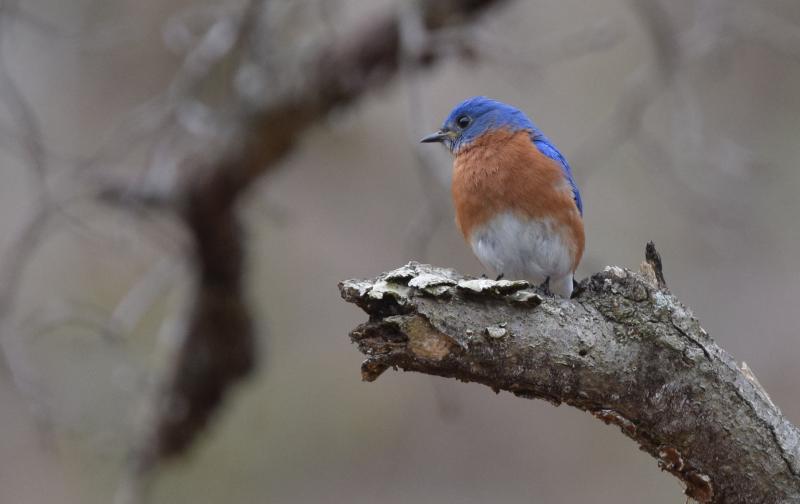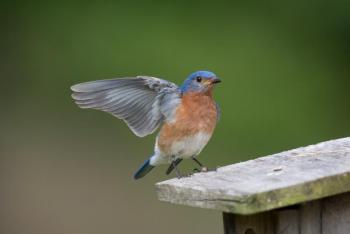The backyard feeders of Mom Wells and brother Andrew, both along Midcoast Maine, have been blessed with the brilliant blue and orange of eastern bluebirds this winter. We have seen a few in scattered locations in the Augusta area, and birders have reported them at places like Penny Lake Preserve in Boothbay and other locations in the area. Seeing a bluebird still always gets us very excited. That’s partly because when we started birding in the 1970s, bluebirds were considered of conservation concern by many ornithologists. They were even included on a conservation watch list compiled by the National Audubon Society called the Blue List.
The Blue List was essentially derived by surveying some of the most active field birders and ornithologists of the time to ask them which species they felt should be considered of conservation concern based on declines they observed in their regions. To be included on the Blue List, a species had to be recommended by experts in multiple regions. Eastern bluebirds were included on that list during much of the 1970s and into the early 1980s.
Eastern bluebirds were probably not particularly widespread and common in much of New England prior to widespread European immigrant colonization and likely increased after forests were cleared for agriculture over large portions of the landscape. Bluebirds naturally occur in large openings in the forest as may have occurred from large fires. So orchards, field edges, and regrowing harvested forests that occupied more of the land over time probably favored an increase in numbers and distribution from historical norms.
But bluebirds are also susceptible to other factors, including severe winters. Protracted very cold temperatures and repeated heavy snowfalls, freezing rain, and rain during the winter period in the core of their wintering range in the southeastern U.S., has sometimes resulted in widespread mortality. The following summer after such an event, there are, obviously, fewer numbers of breeding birds farther north.
Concerns were also raised during the 1970s about the impact of the loss of natural nesting cavities as bluebird habitat was lost to human development. Competition for nest sites with introduced European starlings, which also nest in tree cavities and nest boxes, played a role as well.
One of the concrete ways that was suggested to help bluebirds in those days was to build and put up specifically designed nest boxes for bluebirds. The idea was to make them with holes that were too small for starlings to use and to place lots of them out in favorable places. Bluebird trails—which are nest boxes placed at regular intervals along roadsides--became very popular projects. Some people put out hundreds of bluebird boxes extending over miles and miles of roads. The best bluebird trails were then maintained with regular inspections to make sure they were all in good shape. Sometimes this was coupled with banding or other kinds of research.
Today, eastern bluebird populations appear to be doing very well including here in Maine. The standard breeding survey (Breeding Bird Survey) and the Christmas Bird Count show a steady increase in abundance in the state since the 1960s. The numbers in winter have shown a particularly noticeable increase, with the number on Christmas Bird Counts increasing from 68 in 2007 to 903 in 2020!
There is still much to be learned about eastern bluebirds and monitoring their population status and changes in distribution will continue to be important. Remember that participating in projects like the Audubon Christmas Bird Count, eBird, Climate Watch, the Great Backyard Bird Count, the Maine Bird Atlas, the Breeding Bird Survey, and others is a way for anyone to help!
Jeffrey V. Wells, Ph.D., is a Fellow of the Cornell Lab of Ornithology and Vice President of Boreal Conservation for National Audubon. Dr. Wells is one of the nation's leading bird experts and conservation biologists and author of the “Birder’s Conservation Handbook.” His grandfather, the late John Chase, was a columnist for the Boothbay Register for many years. Allison Childs Wells, formerly of the Cornell Lab of Ornithology, is a senior director at the Natural Resources Council of Maine, a nonprofit membership organization working statewide to protect the nature of Maine. Both are widely published natural history writers and are the authors of the popular books, “Maine’s Favorite Birds” (Tilbury House) and “Birds of Aruba, Bonaire, and Curaçao: A Site and Field Guide,” (Cornell University Press).






























